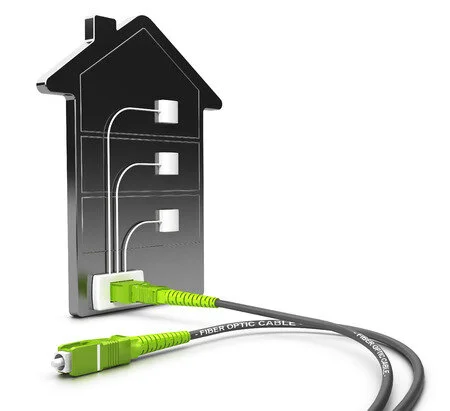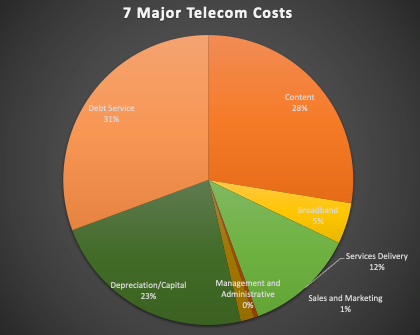The 7 Major Costs in Providing Telecommunications Services
Providing telecom services? Focus on cost recovery of these operating expenses
There are more financing and grant options for potential broadband providers, the business seems poised for a growth spurt benefiting consumers
Municipalities, utilities, and electric cooperatives are providing telecommunications services - cable TV, high-speed internet, and telephony - to underserved customers.
As more customers “cut the cord”, cable TV services are becoming less desirable to offer and more new systems are providing the fiber to the premise and internet services only.
The 7 major costs in providing telecom services are:
Content
Broadband connections
Services delivery
Management and administrative
Sales and marketing
Depreciation/routine capital
Debt service
A feasibility study should serve as a decision point on the finances involved with providing telecommunication services - one of the go, no-go decision tools
If your utility or co-op has ever considered getting into the broadband business, there are more grant options available.
Our community is underserved with high-speed broadband - Our city and electric utility are ready to step in with service
If your community or utility is contemplating establishing a telecommunications utility to provide services (cable tv, broadband internet, phone service), there are many considerations. This article scratches the surface of the details on the costs that will be incurred in proving telecommunications services.
In your evaluation process, you’ll undergo a feasibility study to determine the estimated costs that will be incurred, the forecasted percentage of the community that will take service, and the rates that could be charged and applied towards costs recovery. The feasibility study is the linchpin in your decision whether to proceed with providing services. The feasibility study should perform a traditional SWOT (strengths, weaknesses, opportunities, threats) analysis and forecast operating costs. What are those costs?
Typical construction costs
Construction costs for a fiber system are approximately $30,000 per mile ($27,000 in 2017 dollars). Building for maximum speed and expansion would require building out a fiber to the premise system (FTTP) which is approximately $500 - $800 per residence, including the set-top units. Other equipment, such as the headend (the receptor for cable TV), internet connection, and fleet vehicles are also part of the startup costs. Municipalities, utilities, and co-ops generally use debt financing for construction costs. Financing methods include revenue bonds, bank loans, grants, and loans from other city departments, usually the electric utility.
The system in this cost case study cost $32 million to construct, with the fiber passing 8,500 potential customers. The system serves 3.500 customers, The construction cost per potential customer was $3,800 and the cost per current subscribers (3.500) is 9,100. The system is located in a town of 34,000 population, with a population density of 1,500 per square mile. Less population dense communities could incur higher per customer construction costs, while more dense areas would potentially incur less per customer construction costs.
The basic costs to provide telecommunications services
The 7 major costs in providing telecom services are:
Content
Broadband connections
Services delivery
Management and administrative
Sales and marketing
Depreciation/routine capital
Debt service
A typical breakdown percentage of these costs is shown in Illustration 1:
Typical Cost Structure for Providing Telecommunications Services
What are these typical costs made up of?
The key to successfully providing services lies in strategy, business processes, planning, and cost management. This link takes you to a UAES article on the first three areas, and the remainder of this article gives an overview of each cost area.
Content and broadband access costs
Content and broadband access costs are purchased from providers who bundle these packages in different tiers of services and costs. Factors include subscribers and bandwidth.
2. Services delivery
Services delivery includes system hookups, maintenance, and field technical support.
3. Management and administrative costs
Management and administrative costs include management oversight, accounting, information technology, systems, and billing and collections of customers.
4. Sales and marketing
Sales and marketing includes advertising, sales teams, customer service discounts, and other marketing costs.
5. Depreciation
Depreciation is the accounting treatment of fixed assets that are “used up” each year. For example, the useful life of the cable is 20 years, so, each year 1/20th of the original installation cost of the fiber is part of depreciation expense. This amount is included in customer rates. So, in theory after 20 years customers will have paid for the original installed cost of the cable and those funds could be applied towards replacement of that cable.
6. Routine capital items
There is an ongoing amount of routine capital work done each year. This would include replacement of system components, swapping out of set-top boxes, replacement of fleet vehcles, and other technology. The funding for these routine replacements is through depreciation expense.
7. Debt service
Debt service is the principal and interest payments on the debt that was issued to fund the construction of the telecommunications system.
Setting customer rates
The costs detailed in the feasibility study determine the rates that would need to be charged to provide service. Is the goal to provide a return on investment for providing service? That return can be used to pay for debt service and system expansion and provide cash reserves. Or, should the telecom venture be operated as a non-profit, in which case, revenues are set to equal expenses. That opens the door for fluctuations in rates as budgets change from year to year.
Best practices are to set a return on the capital investment in infrastructure and fund depreciation expense in user rates. This provides greater stability in cash flows and provides cash for system replacement and upgrades. The return on capital investment can be set at the cost of capital rate (link).
Grant funding in the Infrastructure Investment and Jobs Act
The 2021 Infrastructure Investment and Jobs Act includes $65 billion of broadband funding including $45 billion of grants for expansion of broadband services through a Broadband Equity, Access and Deployment program. Other program highlights include:
The Act contains $2 billion of grants to extend the Tribal Broadband Connectivity Program and $18 billion of funding for other initiatives and cybersecurity
The Act's goal is to bring broadband service to "unserved" and under-served areas.
Broadband speed is defined as 25 megabits per second for downloads and 3 megabits per second for uploads.
While the Act was passed in 2021, it took some time for the funds distribution process to be worked out. The funds are starting to trickle out now for projects, but as this is a five-year program, there is time to build out your project plan, perform a feasibility analysis, and determine if the project is cash flow feasible and fits with the IIJA grant program requirements. If the project looks promising, ramp up your grant process and apply.
Business planning is key to success in providing telecommunications services and sustaining the business
The journey towards proving telecom services can be winding and fraught with some blind curves and detours. But, the roadmap is the feasibility study, which, most importantly will give a thumbs up or down indication to move ahead, and then lead through the process of establishing service. After the feasibility period has ended, operating a telecommunications utility will become part of the annual business planning and budgeting process of the organization. Even if your community or utility receives funding under the 2021 Infrastructure Act to do a build-out of a fiber network, a feasibility study is needed to determine future operating costs which must be paid by customers once the funded is depleted
The full course library contains over 30 hours of on-line/on-demand courses on operations and construction project accounting, rates, and management for new and experienced co-op and utility professionals and Board members. Also included are free videos on industry topics and free downloads that you can use in your day-to-day work right after download. Click on the button to see the full course library.
About Russ Hissom - Article Author
Russ Hissom, CPA is a principal of Utility Accounting & Rates Specialists a firm that provides power utilities rate, expert witness, and consulting services, and online/on-demand courses on accounting, rates, FERC/RUS construction accounting, financial analysis, and business process improvement services. Russ was a partner in a national accounting and consulting firm for 20 years. He works with electric investor-owned and public power utilities, electric cooperatives, broadband providers, and gas, water, and wastewater utilities. His goal is to share industry best practices to help your business perform effectively and efficiently and meet the challenges of the changing power and utilities industry.
Find out more about Utility Accounting & Rates Specialists here, or you can reach Russ at russ.hissom@utilityeducation.com.
The material in this article is for informational purposes only and should not be taken as legal or accounting advice provided by Utility Accounting & Rates Specialists. You should seek formal advice on this topic from your accounting or legal advisor.

